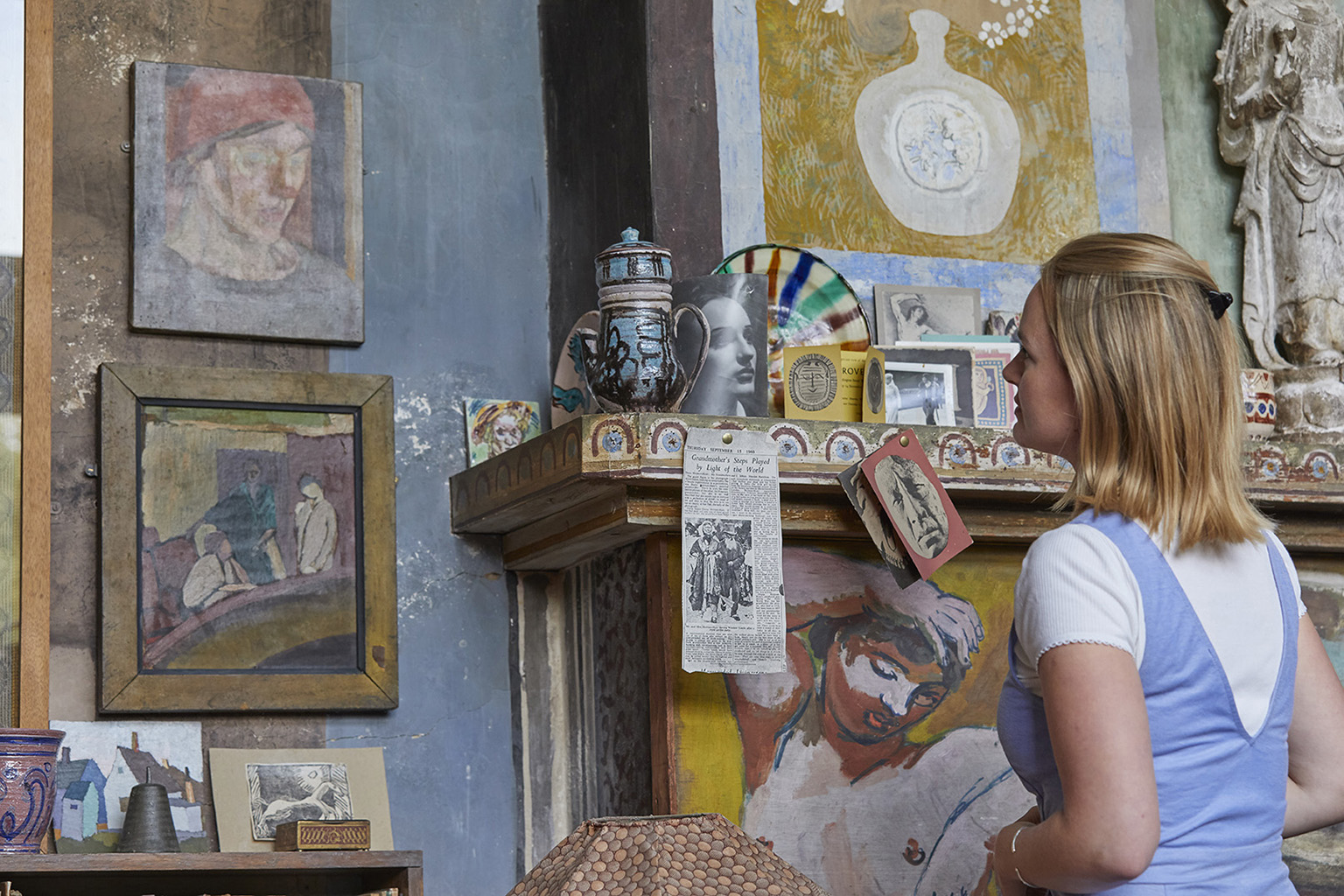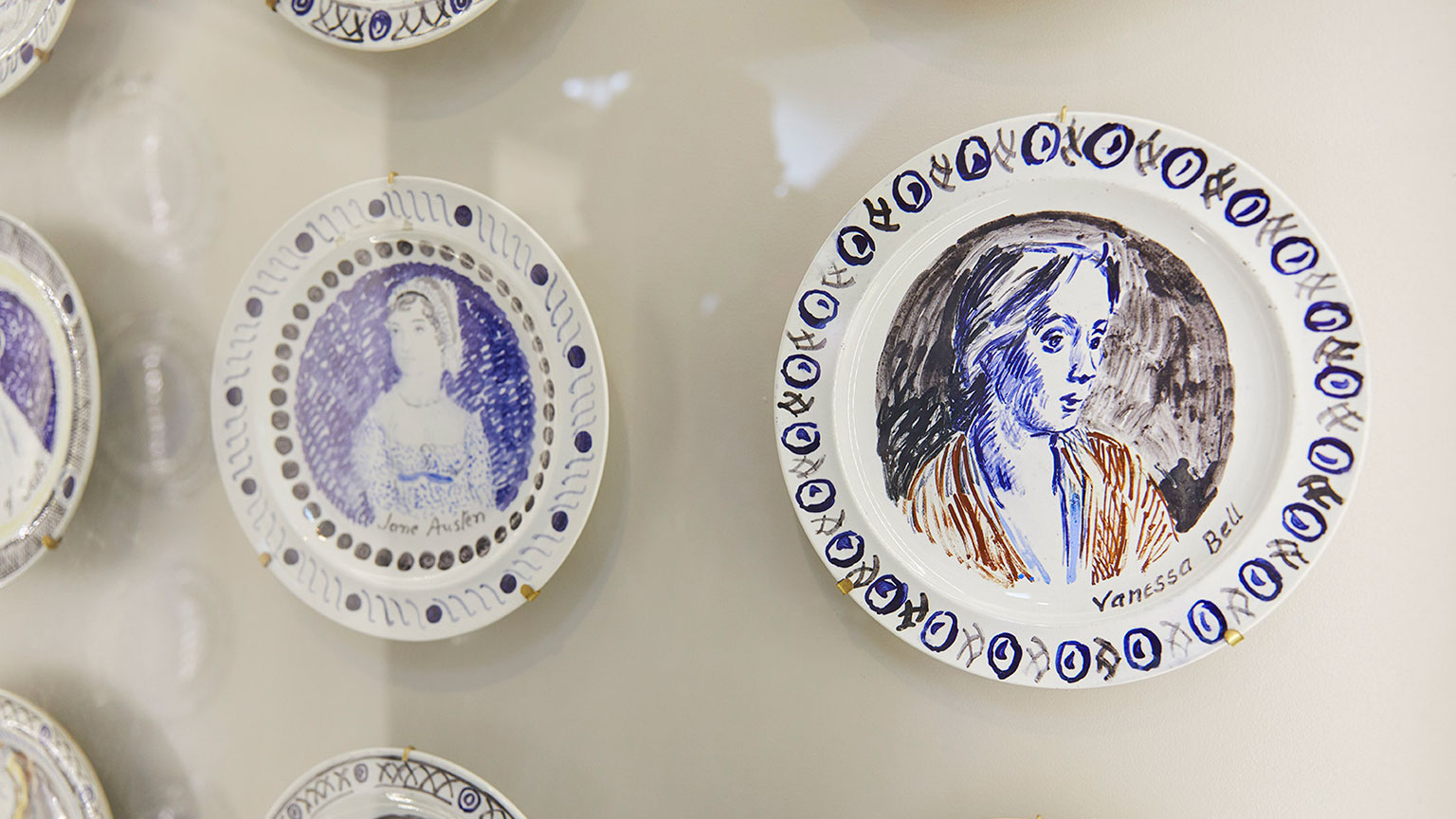Charleston: the Bloomsbury Group’s rural retreat

This East Sussex farmhouse was both home and canvas to the Bloomsbury Group for 64 years. We look back at our Art Partners’ visit to a living time capsule.
From 1916, when the artists Vanessa Bell and Duncan Grant moved in with her children, his lover and Henry the dog, Charleston was decorated and furnished room by room in the Bloomsbury Group’s style – colourful and bold patterns, flowers and figures covering every surface in sight.
It was both a family home and a creative workshop, where many pioneering thinkers and artists of the early 20th century would meet, live, love and work.
While the house has been beautifully restored to its 1950s aspect by the Charleston Trust, it is impossible not to feel the energy and personalities of the group rippling through the decades. From the door panel kicked out by Bell’s young sons while enacting the Sack of Rome (replaced by Clive Bell with a new design in 1958), to the decorated bed in which John Maynard Keynes worked on his history-making The Economic Consequences of the Peace (1919), the house is alive with Bloomsbury stories.

Art Partners' visit to Charleston
Art Fund has been a passionate supporter of Charleston ever since it opened to the public in 1986. And in 2015, Charleston raised much-needed funds through Art Fund's crowdfunding platform, Art Happens, to conserve and protect the fragile paintwork and textiles that make Charleston the only complete Bloomsbury interior in the world.
Our Art Partners, whose support has been instrumental to Art Fund’s involvement with Charleston, enjoyed a bespoke visit to the house in September. After hearing from director Nathaniel Hepburn and head of collections, research and exhibitions Darren Clarke about the history and ambitions of the Charleston Trust, we spent the morning exploring the house in the company of Charleston's expert volunteer guides.
Later we visited the impressive new gallery spaces – opened in 2018 – which, for the current exhibition Post-Impressionist Living: The Omega Workshops, 'have allowed Charleston to borrow great works from the V&A and from the Courtauld,' as Hepburn explains.
Here we linger a little longer in some of the rooms of the house, which hold so many Bloomsbury treasures, and take a look at what makes Charleston the perfect setting for this exhibition.
Exploring Charleston: The Dining Room
It was the First World War that brought the Bloomsbury Group to Charleston; as conscientious objectors, Duncan Grant and David Garnett could only avoid conscription by working at a nearby farm. While the whole country was forced to make do and mend during these years, it is difficult to know where the group’s playful style ends and practical necessity begins. Did Vanessa Bell sew differently patterned fabrics together for the dining room curtains because of a lack of material, or because the idea appealed (our guide reveals that she had a weakness for chintz)?
We see the dining table Bell painted in the 1930s and again with a different pattern in the 1950s. The faded paint where hot dishes were placed while she served her guests seems touchingly symbolic of how the group ‘lived’ their art – with an irreverence that drew few distinctions between the domestic and public.
While they were sewing together fabrics and assembling a hodgepodge of different ceramics on the mantelpiece, they were also bringing together some of the most influential people of their era. Virginia Woolf, EM Forster, Maynard Keynes, TS Eliot and Benjamin Britten all gathered around the painted table. We're encouraged to look at the chairs they would have used – the design is Roger Fry's, the artist and critic who would coin the term 'post-impressionism' and found the radical Omega Workshops which influenced so much of Charleston’s design.

From the Garden Room into the garden
In the Garden Room, where Lytton Strachey's Eminent Victorians (1918) and TS Eliot's The Wasteland (1922) were first read aloud to their friends, our guide draws attention to a rare surviving early work by Vanessa Bell. Iceland Poppies (1908), acquired with Art Fund support, may or may not be filled with biographical symbolism about love triangles – this is also the room where Bell’s daughter Angelica was told her biological father was Duncan Grant, not Clive Bell.
The still life includes a 19th-century French vase, and we are later shown the original in Maynard Keynes’ room – one of the many objects brought back from the group’s extensive travels. Part of the house’s atmosphere comes from the way it holds visible echoes of its own history – the Bloomsbury Group artists frequently painted it and each other.
Also in Maynard Keynes' room, a painting captures the original dining room table design; a portrait of their beloved housekeeper Grace Higgens hangs in a passage; and there are even beautifully decorated box files used by Quentin Bell when he wrote the first biography of his aunt Virginia Woolf.
The Garden Room opens out onto its namesake, which we learn was designed with the same practical creativity as the house. Important for wartime vegetables, it was also a haven of beauty with sculpture and tiled ponds – ‘always an artist’s garden’, as Angelica wrote. It is still planted with Bell and Grant’s favourite flowers.

Clive Bell’s Bedroom
While the Bloomsbury Group’s famously entangled personal lives were not untainted by jealousy and even tragedy, the house is filled with evidence of cheerful collaboration and deep affection. Our guide has a seemingly inexhaustible supply of stories about every lick of paint and stick of furniture – from the stencilled walls, which were epic group efforts, to an enormous cockerel above Vanessa Bell’s window (painted by Grant to wake her up), to Clive Bell’s bed.
Though separated, the Bells remained friends all their lives. He eventually moved in to Charleston himself and Vanessa later decorated the antique French bedstead for him.
His career as a leading art critic is evident in the row of paintings on his bedroom wall, dedicated to him by a number of artists from the Parisian school. It is typical of Charleston that not far from these is Vanessa Bell’s painting Buildings – painted onto a couple of planks of wood that used to be shelves.

The Studio
Designed by Roger Fry on the site of an old chicken run, the studio is very much as Duncan Grant left it at the end of his life. Photos, invitations and pottery crowd the mantelpiece while paints and brushes lie abandoned on a worktop. It looks as if one of the family might appear at any moment to resume work.
We encounter paintings all over the house showing how Grant and Vanessa Bell progressed from realist works to post-impressionism; the studio also offers a snapshot of their wider careers. There are works by and of Edward Le Bas, who was Grant’s model for Christ in his murals at Berwick Church. In a cabinet once owned by William Makepeace Thackeray are examples of dinnerware designed for a selling exhibition at Harrods. There are also prototype plates for The Famous Women Dinner Service (1932), created at Charleston for the broadcaster and art historian Kenneth Clark.
The completed 50 plates, featuring portraits of pioneering women throughout the ages, from Cleopatra to Miss America 1933 (as well as Bell and Grant themselves), reappeared intact in 2017 having vanished from view for over 30 years. There is no question that the set, acquired with Art Fund support, is back where it should be at Charleston. Nathaniel Hepburn sums it up: 'You can imagine them all sitting around the dining table trying to work out those 50 women, and who chose which.'


Post-Impressionist Living: The Omega Workshops
Roger Fry founded the Omega Workshops in 1913, with Bell and Grant as directors, determined to bring a ‘spirit of fun’ to furniture and fabrics. They designed carpets, textiles, furniture, paintings and ceramics which broke decisively from the formality of conventional Edwardian interiors. 'That’s something we tried to capture with the exhibition,' says Darren Clarke, who curated the show, 'So we’ve got a dynamic colour palette and hopefully an interesting way of hanging things.'
Bell and Grant brought their Omega dinner set with them to East Sussex, and Art Fund’s most recent Charleston grant went towards the purchase of a painting by Bell, Study of a Woman (c1917) – featured in the exhibition – whose subject is depicted in front of shelves of Omega plates.
The workshops also embraced a social and democratic role, employing young artists at a difficult time, and leaving works unsigned so customers had to follow their own taste rather than famous names. The Omega Workshops exhibition is a reminder of how radical the ideas advanced at Charleston were, and how their influence would extend far beyond the farmhouse walls.
As Clarke observes, the Omega vision was ‘very much like Charleston: extending the post-impressionist aesthetic beyond the canvas, beyond the picture frame, into the house and into the way people live.’

Art Partners are a group of Art Fund patrons who join us for unique opportunities to get closer to the art they support. They play a vital role in our work with museums and galleries across the UK.
We visited Charleston to view its remarkable collection, and to see the exhibition Post-Impressionist Living: The Omega Workshops, in September 2019.
If you'd like to find out about joining us for opportunities such as this, learn more about Art Partners here.
The more you see, the more we do.
The National Art Pass lets you enjoy free entry to hundreds of museums, galleries and historic places across the UK, while raising money to support them.